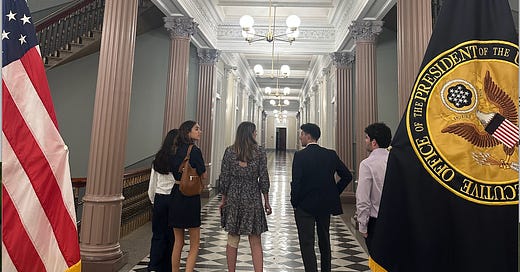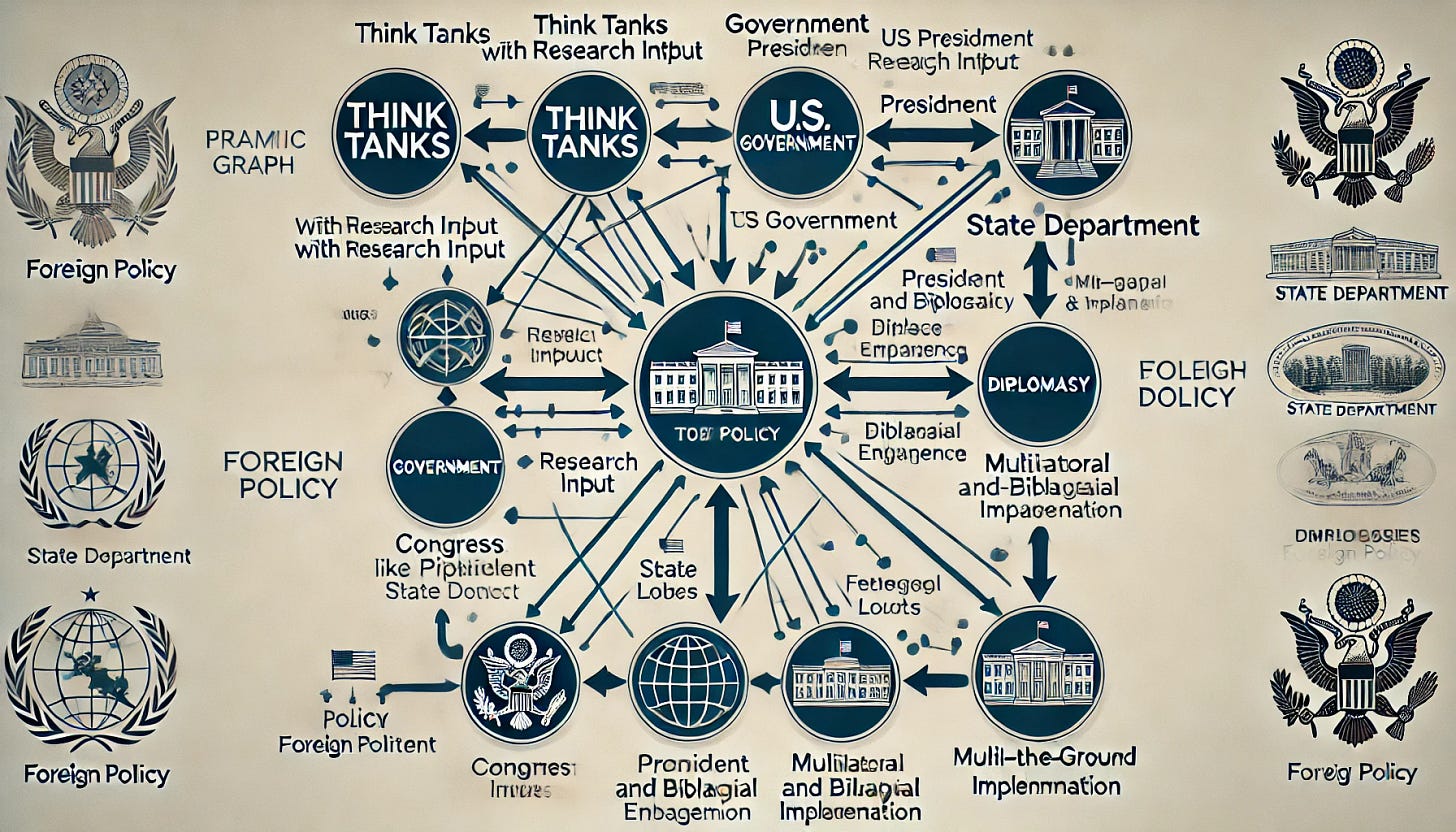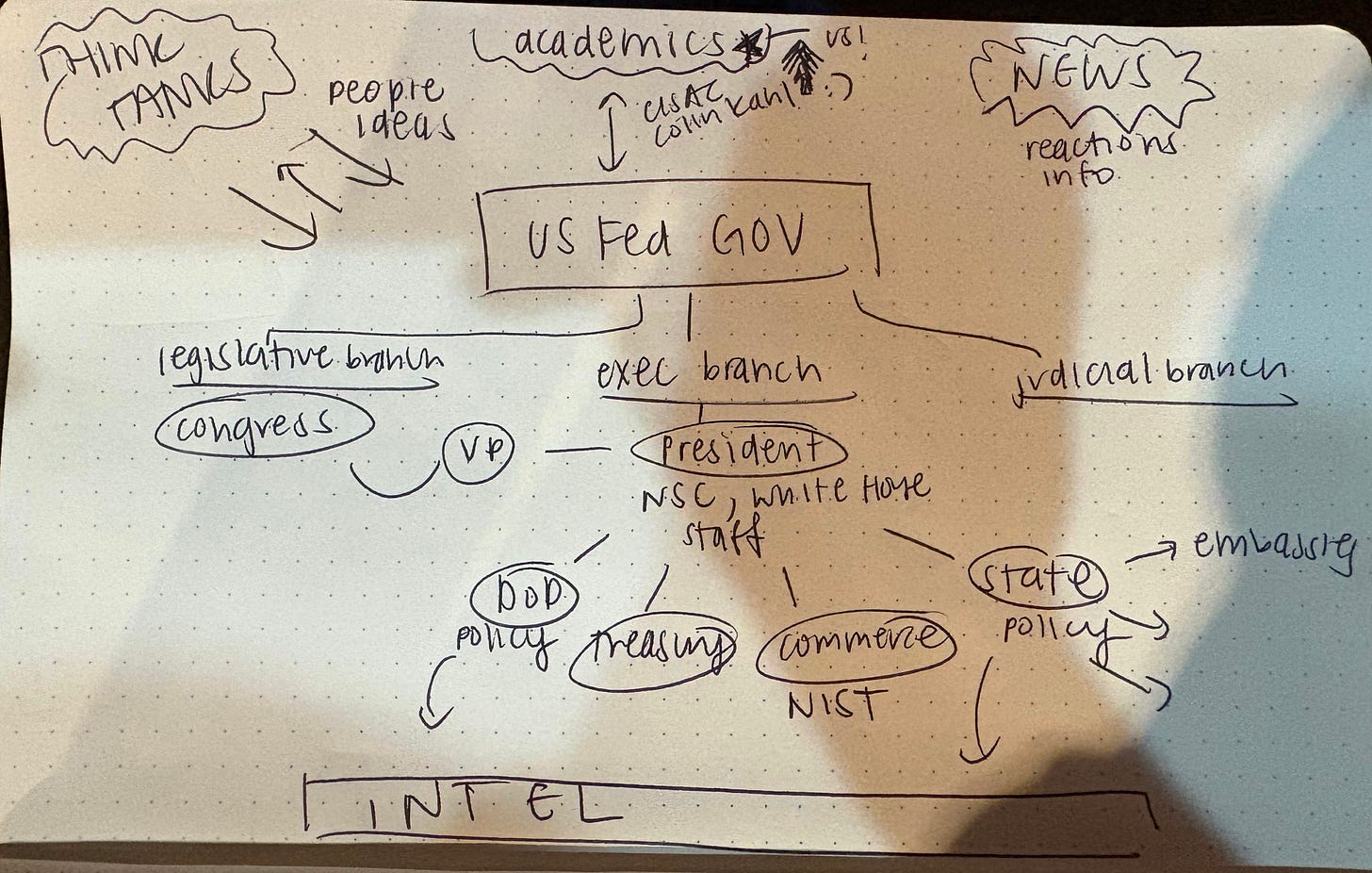Good morning dear reader. No matter how you are feeling post Tuesday’s election, one thing is clear: In January we will have a new government. And as Vice President Harris so aptly put it: “It is time for us to do what we have been doing. And that time is every day.”
I’ve had multiple people this week ask me if I’d work for a Trump administration. To that, I ask: in what context and position?
Enter…the second article on my Center for International Security and Cooperation (CISAC) experience in DC: who determines foreign policy and national security in the government and how you could perhaps contribute to this mission.
I’ll note two things 1) most federal jobs are largely apolitical (so the president doesn’t really impact your work) and 2) as @Josh Hechtman kindly reminded me their biggest variance is pacing.
Whether you are a freshman looking for an internship or a senior looking to start a career, here’s what I’ve learned about how you can get involved.
The best way to explain the interactions of the government+ ecosystem are with an org chart. Here is ChatGPT’s take on it:
Yeah, not helpful. If even Chat can’t make it easy, you know it’s complicated. My specialty is not graphics, but here’s my rudimentary version:
Let’s get into these players.
The News
TLDR: if you want to be an external analytical investigator
Timing: fast work, fast impact
A key takeaway I had from meeting with the New York Times in September is that journalists “are not here to be neutral we are here to be independent.” In their everyday, journalists focus on fact based analysis to deliver fast paced news. Nowadays, only 1/3 of their content is print. Most large publications have largely invested in digital content, videos, and interactive sections like games to boost user engagement, opening a variety of roles for students with CS, writing, or design backgrounds.
Think tanks
TLDR: if you want to train for a position in government, while doing analytical writing that could impact policy
Timing: medium work, slow impact
As representatives from the Center for New American Security (CNAS) told us the goals of a think tank are to 1) research 2) conduct track 2 dialogue (will be explained below) and 3) develop policy talent. Think tanks maximize for “impact, training and learning” and their “theory of success,” as one speaker put it, is to preemptively think about solutions before the problems come up. They can measure demand for their work through citings and invitations to congressional hearings. However, they do not make decisions, they advise and try to get in the heads of policy makers. Brookings would say they are at the nexus of academic rigor and policy relevance and range from the ivory tower to scholarly practice. American Enterprise Institution (AEI) dubbed it college without the annoying (ouch) students.
Diplomacy
TLDR: if you want to be engaging directly with international parts
Timing: medium work, medium impact
Diplomacy can be broken into tracks. There is track 1 which is officially diplomacy done by the State Department. Track 2 is unofficial dialogues that people like think tanks can organize. Track 3 is people to people diplomacy which can be everything from celebrities to sports. In essence anyone can be a diplomat in their own sense. If you want to work directly at an embassy, track 1 diplomacy, there are a couple direct paths. You can either be a foreign state service officer and work your way up (think the Diplomat) or be appointed by an administration (i.e. have hella connections).
Intelligence (CIA+)
TLDR: if you want to do discreet analysis to inform policy making
Timing: classified work, classified impact
As Deputy Director Michael Cohen says, the Central Intelligence Agency (CIA) is focused on using “human enabled tech” to complete a “tech enabled human mission.” The mission of the CIA as a whole is to 1) collect 2) analyze 3) conduct covert action 4) create foreign liaisoning opportunities (lines of communication when track 1 diplomacy fails) and 5) counterintelligence. They recognize the need for technology in their mission and as such created InQtel—their venture capital branch. Unlike most VC funds, InQtel’s mission is not to maximize return but rather to collect secure products for intelligence. A common misconception—most operatives are not doing spying themselves but instead recruiting candidates from foreign nations to be spies. Most of their job focuses on spotting, assessing, developing, recruiting and continually assessing their candidates. Debates that we saw continuing especially over at the Office of the Director for National Intelligence (ODNI) have been the need for strategic declassification, needing intel that is relevant and timely and, in the case of Ukraine, the use of intel for post conflict responsibility holding. As one officer put it the “IC is closer to academia than any other part of the government. And they are building their own in house AI models.
Departments and Agencies
TLDR: if you want to work in a more specific, slower moving part of government policy making
Timing: slow work, slow impact
Government departments and agencies follow a clear hierarchical structure, with departments typically overseeing various agencies (see above). During my work at the Cybersecurity and Infrastructure Security Agency (CISA), I experienced this structure firsthand as we operated under the Department of Homeland Security. Our DC trip included visiting the Department of Commerce, which houses several research agencies including the National Institute of Standards and Technology (NIST). One notable initiative within Commerce is the U.S. AI Safety Institute led by girl boss Elizabeth Kelly. While this institute lacks direct enforcement authority, it serves a crucial information-gathering mission focused on three key areas: mandatory reporting requirements, red team testing, and advancing scientific research and understanding. We also visited the Department of the Treasury, which aspires to be the "coin of our realm." Their primary focus centers on directing trade and investment toward appropriate enterprises.
White House+
TLDR: if you crave startup energy and hours paired with a lot of coordination and a fair amount of flashiness
Timing: fast work, medium impact
The White House operates through three main organizational structures: the Cabinet, specialized Offices, and the National Security Council (NSC). The Cabinet consists of department heads who serve as the President's key advisors, while specialized offices like the Office of Science and Technology Policy (OSTP) and the Office of Management and Budget (OMB ) handle specific policy domains.
The National Security Council, which we had a chance to visit, plays a unique coordinating role, but must navigate complex interagency processes to build consensus. This involves bringing together representatives from relevant departments and agencies to align on policy decisions. When agreement is reached, the White House can take action through two primary mechanisms: Presidential Memorandums (like the one on AI that was recently released) or Executive Orders. These directives can rapidly implement significant policy changes across federal agencies.
However, this executive authority comes with a significant limitation: these directives only remain in force during the issuing president's tenure. The next administration can easily revoke or modify them, creating potential instability in long-term policy implementation. This is why many significant policy changes ultimately require Congressional action to achieve lasting impact through statutory law.
Congress
TLDR: if you want to hustle, negotiate, and handle money for the chance of longterm impact
Timing: fast work, slow impact
Congress wields significant influence over national security primarily through its "power of the purse" - similar to how the ASSU undergraduate senate controls club funding, but on a massive federal scale. The most crucial piece of national security legislation is the annual National Defense Authorization Act (NDAA), which not only sets the Department of Defense's budget but often includes wide-ranging provisions affecting technology, cybersecurity, and emerging threats.
Our meeting with a congressman highlighted the NDAA's expanding scope beyond traditional military matters. The act now frequently includes provisions about artificial intelligence, supply chain security, and technology competition with other nations. Congress shapes security policy not just through direct legislation, but through oversight hearings, required reports from agencies, and specific funding allocations or restrictions. However, like student government, getting anything done requires building coalitions and navigating competing interests - though instead of campus clubs, it's national security agencies and defense contractors vying for resources and influence.
Unlike executive orders, these congressional actions create lasting changes that persist across administrations, making them particularly powerful tools for long-term national security strategy…if you can get them passed.
Wow, this post got long. As always, take what I say with a pound of salt and keep in mind: SWE jobs may not be hiring in this economy but the government certainly is.
Your reward for making it to the end? Some (anonymous for the sake of privacy) general words of wisdom I collected from the trip.
“The amount of sh*t I have NOT gotten is a lot”
“No one wants to work with jerks”
“To speak with clarity 1) avoid jargon 2) Say WHO is doing what and 3) write before you talk”
“Know your history before you know the news”
“Mastery + Grit leads to success”
“Find your superpower”
“Managing a team is 80% process and people and 20% outcome”
“Focus on intrinsic not instrumental choices”
Onwards.
—DG







